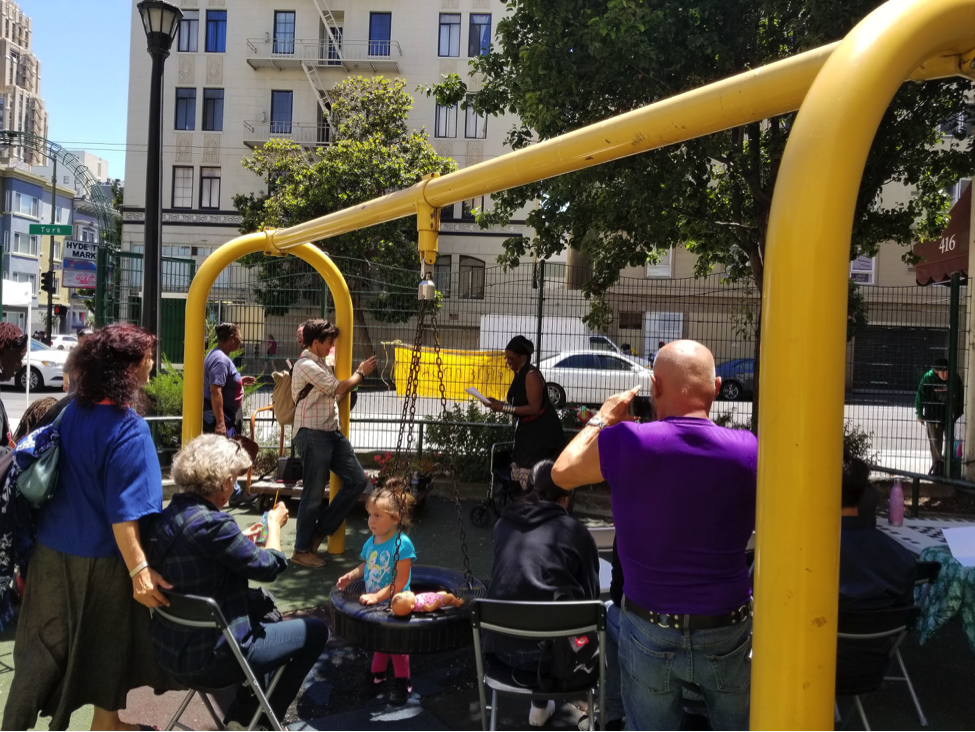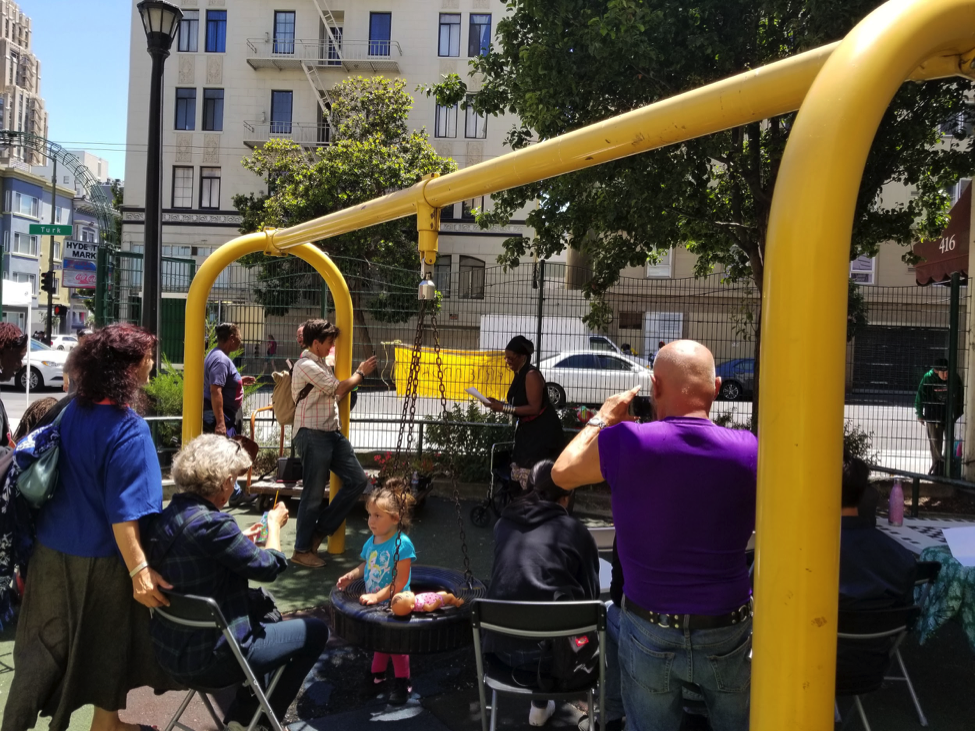Rita sings during an activation of the Turk Hyde Mini Park Pilot program.
On December 31st, 2017, TLCBD’s several-month permit to activate the Turk and Hyde Mini Park expired in anticipation of the park’s closure for a major renovation. The park’s renovation has been delayed, and while we look forward to it’s eventual rebirth, TLCBD and its community partners put significant investment into bringing positive change to the area in 2017, and are working to get back to build upon that investment in 2018.
With that, we thought it a good time to look back at some of the experiences we had, and the people who helped usher in that positivity.
First, some background:
As we know, the Tenderloin faces among the highest crime rates in San Francisco. Drug sales, open drug use, and cleanliness pose a significant threat to public safety and quality of life, and the corner of Turk and Hyde is no exception.
Despite these issues, we are a neighborhood of rich diversity, culture, history and working class families, including the highest concentration of children in San Francisco.
In 2014, the reopening of Boeddeker Park following a major renovation proved an area of the neighborhood could be sustainably transformed from a hotbed of negativity to a shining beacon of positivity.
Could the success of Boeddeker Park be replicated to this park and its immediate vicinity? What if community members could begin activating the park in a positive way ahead of the renovation? Could this build stakeholder buy-in while creating a sort of muscle memory for positive uses while changing perception for residents and visitors?
In the summer of 2017, TLCBD entered into an agreement with SF Rec and Parks, granting a several-month blanket permit (through December 31, 2017) to regularly steward activation with the help of community partners who would form a Steering Committee to guide a pilot activation program at the park.
The Steering Committee
The Steering Committee was made up of Tenderloin residents and community members within proximity to the park as well as other stakeholders. Nonprofit Demonstration Gardens, under the umbrella of Friends of Turk-Hyde, became the anchor partners to TLCBD.
Other members included Tenderloin residents, including representatives from Tenderloin People’s Congress, and the Faithful Fools. The Trust for Public Land and Saint Francis Foundation’s Tenderloin Health Improvement Partnership were in step with the progress. The office of District 6 Supervisor Jane Kim was occasionally represented. San Francisco Tenderloin Station was also aware of the activation and could provide support if necessary.
From the onset, the group agreed to meet regularly to plan the rollout and implemenation of the pilot, discuss ways to evaluate successes and challenges, plan for future activities, share the progress of the park, and consider ways in which the pilot could inform the design while advocating, if appropriate, for future stewardship.
The Pilot Launch
The Steering Committee quickly came to consensus on the style of launch, which internally was termed “quiet invitation” extended to all community members, including those previously engaged in ‘negative activity’ in and around the park.
During the posted pilot hours Tenderloin Safe Passage Corner Captains would position themselves as a welcoming presence outside the entrance to the park. TLCBD Clean Team would increase pressure washing weekly in the early hours to lift the park into a more attractive state. Daily sweeps would remove any debris, litter, and other health or safety hazards, including discarded needles.
Each activation day, TLCBD staff and Safe Passage Corner Captains wheeled more than 100lbs of tables, chairs, and a tent down the cracked sidewalks of Hyde Street from our offices on Ellis Street. Meanwhile the Demonstration Gardens Stewards would do the same northward carrying books, magazines, games, gardening tools, as well as art and music making materials. Together the two groups met at the park to begin the activation.
TLCBD Safe Passage staff routinely cleaned up and engaged with users inside and outside the park as well as passerby during the park shifts. They would negotiate the immediate stoppage of any negative behavior happening inside the park, establishing the play area as a safe and inviting space for all community members engaged in healthy, positive activity.
The initial schedule was Tuesdays, Wednesdays, and Thursdays from 1-3pm, with refreshments served on occasion. Daily sweeping, cleaning and weekly pressure washing.
An Investment In People
A goal set forth by the Steering Committee was to cultivate community member buy-in, or “ownership” of the park in order to nurture sustainable growth and care in the future.
TLCBD chose to invest $5000 into a micro grant opportunity. Through the Steering Committee it was agreed grants would only be awarded to activators who’d held some connection to the neighborhood.
In addition, TLCBD allotted resources to fund a staff position. We are incredibly honored ot have been able to hire Stephen Tennis, a longtime Safe Passage volunteer and communtiy leader, who became the lifeblood of the Safe Passage presence at the park. He’s kept his staff position with Safe Passage despite the completion of the pilot.
After the six month pilot, Stephen shared with us how he was greatly impacted by the relationships he formed, particulary with the families using the park, and began to “think in much broader terms about [his] role in the both the Safe Passage Program and the community.” Quite a statement coming from someone who’s been championing the neighbhorhood through various organizations and intitiatives for years.
Immediately, neighbors, residents, and passerby began to notice a difference. Qualitatively, they would express gratitdue for the presence Safe Passage’s presence at the park. Others noticed a much higher level of cleanliness. These interactions also served to share information about the upcoming renovation, the pilot program, and as a way to gage what types of activities people would like to see there in the future.
Above all, Stephen shared that his proudest achievement was the ability to cultivate respect for the park from the street level drug dealers and others that had surroudned it. By his example of continuious cleaning and sweeping the perimeter, and his manner of speaking respectfully to all, he could cultivate mutual resect and positive behavior. People began to bring their trash to the receptacle he brought with him. During the pilot, dealers no longer congregated or conducted transactions along the parks perimeter, let alone inside the park. Toward the final months of the activation, Stephen began to bring resource materials for services, shelter, food and clothing as well as jobs. On a daily basis, 15-20 people would stop outside the park to talk with Corner Captains beneath the TLCBD tent to ask about the resources, thus cultivating community pride through shared information while further defining the park as a place to receive health and wellness not just in the form of activity but also in the form of resources.
Parents, especially in the summer months of the activation when school was out, expressed gratitude, with one saying how it was a watershed moment to be able to look down at her phone knowing her todder could play safely because Safe Passage was in the park. It also increased her visits to the park on weekends, whereas before she’d travelled further to other parks.
Her experience echoes what one artist activator, Ramekon O’Arwisters, shared about his experience bringing his social practice art, Crochet Jam, to the park:
“What’s different here is that you’re bringing calm inside of an environment that is not always calm. When you have calm you are able to reflect rather than react. Everything that’s happening in the street is about reaction,” he said, referencing the quality of
life issues the pilot program in general, and his art practice activation specifically, was working to assuage.
Many of the micro grant recipients brought similar, calming activities that brought a sense of wellness to the park.
Rita Wittaker, a vocalist and Tenderloin resident participant of the Skywatchers ensemble provided acapella singng several times throughout the pilot program. She described how the opportunity created in her a sense of purpose and hope, aiding her in a battle against addiciton. She said, after one activiation, “There is a light that shines within me that I hadn’t seen in a long time. This has been an opportunity to shine my light to my neighbors here in the TL.”
Indeed, it seemed to work. Many of the people engaged in negative activity outside the park seemed to calm at hearing Rita’s voice. Even passerby stopped along the fence as Rita sang, enjoying a peaceful moment as they waited for the bus or simply went about their day. On two occasions, we witnessed people weeping joyful tears, perhaps struck by some memory by the soulful songs Rita chose.
After two months, the Steering Committee evaluated the data collected and decided to add Friday to the schedule. Eventually, Mondays were also programed with wellness activites.
Below is a full list of Micro Grant Recipients who brought programmed activites to the park:
· The Healing Well- Gentle Movement Classes
· The Tenderloin Housing Clinic’s Central City SRO Collaborative- Resident Rights Resource Fair, which included fun activities covering topics, such as disaster preparedness.
· Shih Yu-Lang Central YMCA- children’s activity as well as tai chi
· Skywatchers, through Rita whittaker’s prerfomrances as well as drumming by another participant, Dino Smith.
· Faithful Fools, created a listening booth
· The Luggage Store served as fiscal sponsor to Ramekon’s Crochet Jams.
· SF Recovery Theater provided entertainment and tai chi, as well as ehalthy food access demonstration.
· Salvation Army Ray & Joan Kroc Center brought acitivties for kids
Other community partners interested in activation included CounterPulse, Hospitality House, and the Tenderloin Boys & Girls Club.
Conclusion
In the end, the Turk Hyde Mini Park Pilot Program was a great success. We set out to create a safe, clean, welcoming atmosphere on an extremely troubled park. We cultivated community member buy-in while transforming the negative uses of the park into positive experiences.
During the pilot program, we served 2,308 people and programmed 123 activations through micro grants.
Habitants along the perimeter and nearby neighbors knew our schedule to memory, they knew the reason for the activation, and would even help out when needed in the form of aiding the build up and take down of the tent each day and the aforementioned cleaning. During the activation, the park became known as a place where all community members could coexist.
Challenges such as access to storage, water, and design elements could be addressed through additional resources and the later redesign respectively while having a significant impact on the future success of a similar endeavor. Additional resources would also enable the addition of more staff, which would aid in outreach to senior populations and expanded the programming.
We believe this is a worthy project which can have a tremendous impact on the physical environment in and around the park while greatly improving the quality of life for the people it serves and in essence the greater Tenderloin community.
We can’t wait to get back to Turk-Hyde!



Comments are closed.